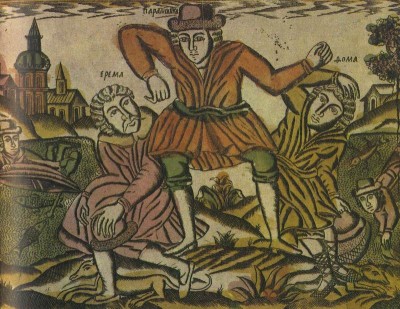The Tale of Foma and Erema
The comic Tale of Foma and Erema, a fable about two unfortunate brothers, is full of despair.46 Here use is made of the most widespread device in mediaeval art, that of contrast. When a zealot is contrasted with a sinner, for example, they are portrayed in two colours only, black and white, without any nuances or semi-tones. Foma and Erema are also contrasted with each other, but it is a pseudo-contrast, a caricature contrast. The author makes use of the adversative conjunction “but” to link synonyms instead of antonyms. He gives the following portraits of the two brothers: “Erema had one eye, but Foma had a cataract, Erema was bald, but Foma was mangy.” They go to church: “Erema began to yell, but Foma began to howl.” The sexton chases them out of the church: “Erema tore out, but Foma ran out.” Life is not easy for the brothers. Fortune never smiles upon them. After being chased out of the church, they are driven away from a feast: “Erema hollers, but Foma squeals.” Their death is as absurd as their life: “Erema fell into the water, Foma sank down to the bottom.”
One of the manuscripts ends with a pseudo-denunciatory exclamation: “Ridicule and disgrace to both the stubborn fools!” This accusation of “foolishness” should not be taken at its face value. It must be remembered that Old Russian humour is universal, that in satirical literature the borderline between the author and the hero, the narrator and his characters, the ridiculer and the ridiculed is blurred and conventional. Therefore the acknowledgement of Foma and Erema as “stubborn fools” is also an acknowledgement of universal “foolishness”, including that of the narrator himself. The satirical texts of the seventeenth century abound in this. “Greetings from your son, God-given and long a fool,” the author of a rayeshnik epistle describes himself.47 This is mock self-denunciation and self-abasement, a “mask of foolishness”, a fool’s grimace, because the “poor and naked” outcast of satirical literature chooses the role of the fool.
He turns his rags into a fool’s cap and bells. In The ABC of a Poor and Naked Man we read: “I had some fine feryazi (loose tunics) made of matting with long laces of bast, and those cruel folk took them in payment of a debt and left me quite naked.” Matting and bast were traditional features of the fool’s attire. Thus, the hero here has adopted the pose of the fool. And it is no accident that this statement comes under the letter fert (Ф): fert was considered a kind of pictogram for the poseur, the dandy, the conceited, worthless person, who stands hands on hips, showing off.
In the language of the seventeenth century the word “fool” had the meaning of “jester” as well. The court appointments of
Tsar Alexis included fools, and the Tsarina Maria Miloslavskaya had female fools and male and female dwarfs who used to amuse the royal family.48 The main paradox of the fool’s philosophy is that the world is full of fools and the greatest fool is the man who does not realise that he is one. Hence it follows that in a world of fools the only wise man is the jester who plays the fool, pretends to be a fool. Thus the ridiculing of the world is a kind of philosophy (and not only a literary device), which develops from contrasting one’s own bitter experience with the “edifying nature” of official culture. The powers-that-be insist that order reigns, but any unprejudiced observer can see that there is constant, insuperable discord between state laws, between Christian precepts and everyday life, and that what reigns is not order, but absurdity. Acknowledging reality to be absurd, satirical literature constructs artistic reality in accordance with the laws of the absurd.
This is clearly evident in the style of satirical literature. Its favourite stylistic device is the oxymoron and oxymoronic combination of phrases (the conjoining of contradictory terms or contradictory sentences).49 Thus, in satirical texts the deaf are invited to hear, those without hands, “to play the psalter” and the legless “to leap about”.
Satirical literature does not invent new genres. It parodies compositions long established in folklore and letters. In order to understand and properly appreciate the parody, the reader and hearer must be well acquainted with the parodied genre. For this reason it is the most common genres that are chosen, the ones that the Old Russian encountered every day, the court case (The Tale of Ruff Ruffson), the petition (The Kalyazin Petition), the book of home remedies, the epistle, the church service.
 History of Russian Literature
History of Russian Literature

